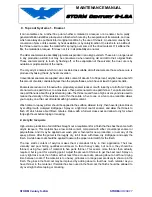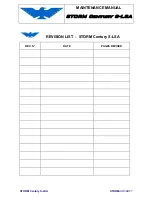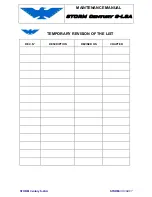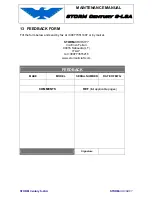
MAINTENANCE MANUAL
STORM Century S-LSA
STORM Century S-LSA
STORMAIRCRAFT
This is a modification of a relative humidity chart, and in order to use it, you must have two mercury
thermometers. Wrap a cotton wick around the bulb of one, and, with the thermometers placed side
by side in the spray booth, blow air from the spray gun across them. This will evaporate the water
from the wick and lower the temperature measured on that thermometer. Locate the temperature
of the thermometer with-out the wick (dry-bulb) across the bottom of the chart, and follow this line
up until it is crossed by the slanting line representing the temperature of the wet-bulb thermometer.
Read the amount of water on the horizontal line through this intersecting point. Let's assume, for
instance, that the dry-bulb temperature is 70 degrees F and the wet-bulb temperature is 60 degrees.
These two lines cross above the horizontal line indicating 0.09 pound of water per pound of dry air,
actually at about 0.095 pound. This means that there is enough water in the air to properly convert the
acid in the primer.
If there is not enough water in the air for proper conversion, the finish will trap active acid against the
metal. In order to prevent this, and the subsequent danger of corrosion, water may be added to the
thinner. The thinner for wash primer is primarily an alcohol, and it will accept water. If there is somewhere
between 0.05 and 0.09 pound of water to each pound of air, you may add one ounce of distilled water to
each gallon of thinner. If there is less water than 0.05 pound per pound of dry air, you may add two
ounces to each gallon of thinner; but this is the maximum amount permissible under any circumstances.
Acrylic lacquer applied over an improperly cured wash primer is porous enough to allow moisture from a
heavy dew to penetrate the film and unite with the free acid and convert it. In the process of doing this,
the paint, primer and all, will be lifted from the surface in the form of blisters. If these blisters appear
shortly after the painting has been finished, allow the airplane to sit in the sun-shine and get thoroughly
warmed. These blisters will go down and the surface will be smooth again. The acid has now received
sufficient water for its conversion and the primer will have its pro-per cure; the finish has not been
damaged, provided the condition was not initially too severe.
Another condition could exist within the wash primer if it is not sufficiently converted and is covered with
an epoxy or zinc chromate primer or a polyurethane topcoat. These finishes are not as porous as acrylics
and will not allow sufficient water to enter to complete the conversion, but will allow enough to penetrate
to react with the acid and the metal to form filiform corrosion.
This is simply corrosion having a thread-like form in which the acid and water have reacted with the metal
and formed a salt, destroying the metal. Once filiform corrosion is detected under any of these films, all of
the finish must be stripped and the entire surface treated to remove every trace of the corrosion.
2 Epoxy primer
The most popular primer for use under the new polyurethane finishes and for any finish where the
maximum corrosion protection is required is one of the epoxy primers. These are two-component
materials which produce a tough, dope-proof sandwich coat between the finish and the surface. Epoxy
primers may be used on aluminum, magnesium, steel or fiberglass, and for the maximum corrosion
protection can be applied over wash primers.
Epoxy primers are not used for high-volume production aircraft because of the long time period required
for them to develop their hold-out. This is the hardness required of a primer to prevent the topcoat sinking
into it and distorting its surface so it loses its gloss. A waiting period of at least five hours, and preferably
over night, is required before topcoating epoxy with acrylic or with enamel. These finishes will soften the
primer and lose gloss if they are applied before the primer has had its full time to cure. Polyurethane
enamels are compatible with the epoxy primers and will not re-lift them, so they may be applied after a
wait of only about one hour. The poly-urethane finish softens the surface of the epoxy and forms a
chemical bond with the primer.
If you ever have to wait more than 24 hours between the time the primer is sprayed on the surface and
Содержание Century S-LSA
Страница 13: ...MAINTENANCE MANUAL STORM Century S LSA STORM Century S LSA STORMAIRCRAFT 1 4 ENGINE SPECIFICATIONS ...
Страница 74: ...MAINTENANCE MANUAL STORM Century S LSA STORM Century S LSA STORMAIRCRAFT Fig 3 24 Fig 3 25 ...
Страница 114: ...MAINTENANCE MANUAL STORM Century S LSA STORM Century S LSA STORMAIRCRAFT CHAPTER 9 ELECTRICAL SYSTEM DIAGRAM Fig 9 1 ...
Страница 129: ...MAINTENANCE MANUAL STORM Century S LSA STORM Century S LSA STORMAIRCRAFT 10 7 3 FIREWALL ELECTRIC PANEL Fig 10 7 ...






































